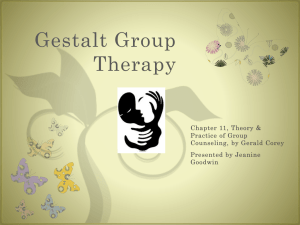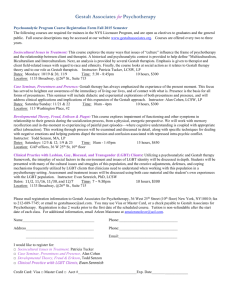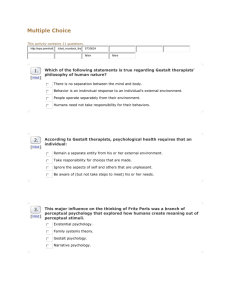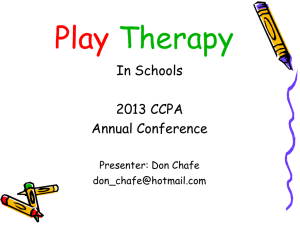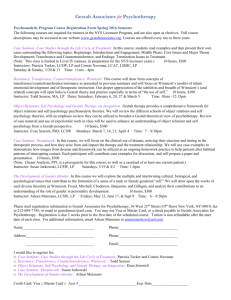Gestalt Theory
advertisement
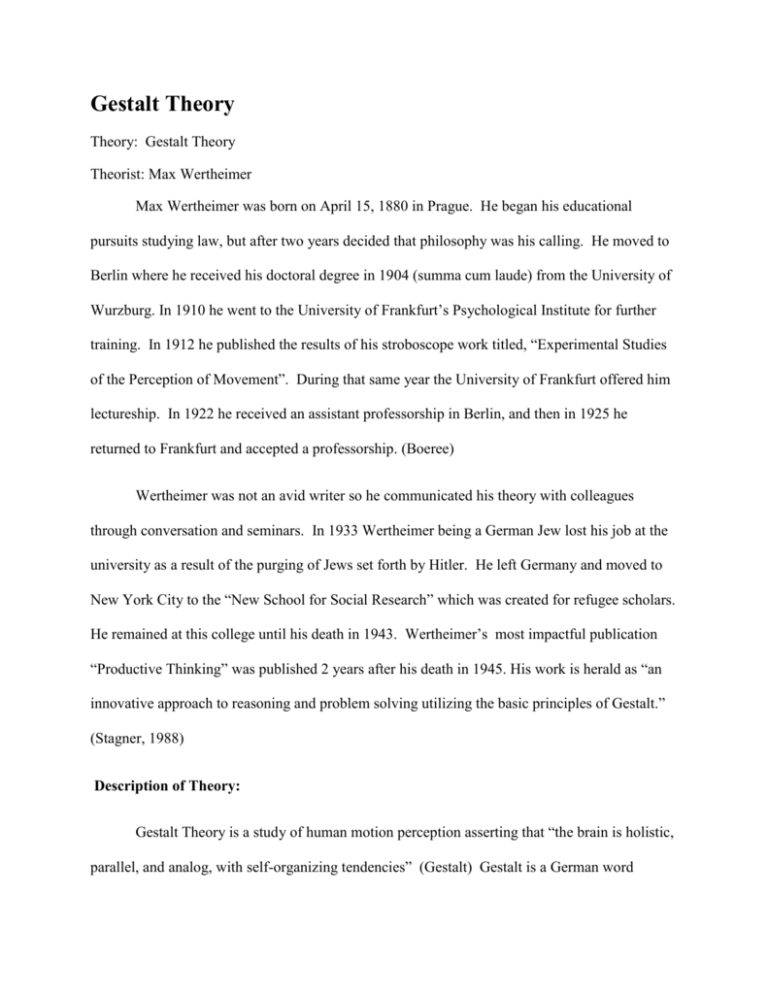
Gestalt Theory Theory: Gestalt Theory Theorist: Max Wertheimer Max Wertheimer was born on April 15, 1880 in Prague. He began his educational pursuits studying law, but after two years decided that philosophy was his calling. He moved to Berlin where he received his doctoral degree in 1904 (summa cum laude) from the University of Wurzburg. In 1910 he went to the University of Frankfurt’s Psychological Institute for further training. In 1912 he published the results of his stroboscope work titled, “Experimental Studies of the Perception of Movement”. During that same year the University of Frankfurt offered him lectureship. In 1922 he received an assistant professorship in Berlin, and then in 1925 he returned to Frankfurt and accepted a professorship. (Boeree) Wertheimer was not an avid writer so he communicated his theory with colleagues through conversation and seminars. In 1933 Wertheimer being a German Jew lost his job at the university as a result of the purging of Jews set forth by Hitler. He left Germany and moved to New York City to the “New School for Social Research” which was created for refugee scholars. He remained at this college until his death in 1943. Wertheimer’s most impactful publication “Productive Thinking” was published 2 years after his death in 1945. His work is herald as “an innovative approach to reasoning and problem solving utilizing the basic principles of Gestalt.” (Stagner, 1988) Description of Theory: Gestalt Theory is a study of human motion perception asserting that “the brain is holistic, parallel, and analog, with self-organizing tendencies” (Gestalt) Gestalt is a German word meaning “A physical, biological, psychological, or symbolic configuration or pattern of elements so unified as a whole that its properties cannot be derived from a simple summation of its parts.“ (Gestalt) In short “the whole is different than the sum of its parts”. (Stagner, 1988) In 1910, Wertheimer the founder of Gestalt Theory was conducting a study of “Apparent Movement” where he experimented with a stroboscope, a device that presents various visual stimuli in time intervals. He presented two images, a vertical line and a horizontal line of equal length at .02 second alternating intervals. His observers saw the vertical line collapsed onto the horizontal line. (Stagner, 1988 pg. 245) He continued these experiments with the Schumann tachistoscope which allowed him to measure down to milliseconds where he found at intervals of 60 ms plus or minus 25 the lines were seen as constant. (Sarris, 1989) This apparent movement was titled by him as “Phi Phenomena”, because “there was no point to point correspondence of stimulus to sensation, as the line did not physically move.” In fact, even seasoned observers could not discriminate between the real and apparent motion. (Sarris, 1989) Phi phenomenon is “an optical illusion of our brain that allows us to perceive constant movement instead of a sequence of images”, succinctly, ”we are inventing information that does not exist”. (Phi phenomenon) We fill in the blanks in order to bring closure and completeness to the perceived grouping of stimuli. This theory was considered rebellious to the accepted “associative” practice of “single stimulus – single response.” (Stagner, 1988, page 244) The results of this research prompted him in 1912 to publish his “first data and interpretations insisting the experience depended on the gestalt, the configuration rather than on elemental stimuli. “ “The phenomena which Wertheimer was investigating could not be explained by the then-prevailing psychology. Psychology was, in 1910, characteristically analytical: in naive imitation of the natural sciences, it attempted to reduce every complex phenomenon to simpler ones, the elements which were supposed to make up the whole.” (Brittanica Concise Encyclopedia: Max Wertheimer) In defense of the Gestalt theory Koffka is on record as saying “It is a mistake, Koffka held, to deal with any stimulus without regard to the field in which it is embedded.” (Stagner 1988 pg. 251, para. 2) A previous professor of Wertheimers and predeccesor to the Gestalt Theory was Christian von Ehrenfels (1859-1932) an Australian philosopher who raised the question, “What is Melody?”. In his research he observed that if a melody is played in one key, then the octave is changed, the listener would still recognize the tune. He called this “Gestalt Quality”, “it meant the pattern of organization could be consciously perceived even if all the elements were changed; (Stagner, 1988) There are five significant Gestalt Principles that help simplify the theory of visual perception; 1) Similarity, 2) Continuation, 3) Closure, 4) Proximity and 5) Figure and Ground. (The model is shown in Figures 1 through 5). Similarity focuses on what an item looks like relative to the other objects in the vicinity (The Gestalt Principles). Whereas, with Continuation the eye will follow the leading in the direction guided by the parts, for example a person pointing and you look in the direction of pointing hand) (exhibit 2). In closure, the mind will place missing parts into a grouping in order to complete the perceived picture (exhibit 3). Proximity is concerned with where an item is in locale to the other parts of the gestalt (exhibit 4), and finally Alignment seeks to create order (exhibit 5). It is the human condition to complete a picture by considering all relevant stimuli in the scope of what is being viewed, thus the collective whole or gestalt. (The Gestalt Principles) Gestalt Theory influences a variety of disciplines ranging from, psychological therapy to education, art, business systems, media, design and anything that seeks to understand, influence or understand human motivation and decision making. Our individual perceptions will vary based on the experiences we have encountered with parts of a whole, and when combined with the “Here and Now”. Gestalt Therapy (1992) para (1), (3), Report Prepared by: Gary M. Ross Works Cited Boeree, D. C. (n.d.). Gestalt Psychology. Retrieved 9 22, 2011, from http://webspace.ship.edu/cgboer/gestalt.html Brittanica Concise Encyclopedia: Max Wertheimer. (n.d.). Retrieved 9 22, 2011, from Answers.com: http://www.answers.com/topic/max-wertheimer Dictionary, A. H. (n.d.). Gestalt American Heitage Dictionary. Retrieved 9 22, 2011, from Answers.com: http://www.answers.com/topic/gestalt Gestalt. (n.d.). Retrieved 9, 17, 2011, from Google Dictionary: http://www.google.com/#hl=en&q=gestalt&tbs=dfn:1&tbo=u&sa=X&ei=aWZ7TtyjGqKQsAKqza3JAw&sq i=2&ved=0CC8QkQ4&bav=on.2,or.r_gc.r_pw.&fp=44042e544f956246&biw=1280&bih=874 Perls, F. S. (1988). Gestalt Therapy Verbatim. Highland, NY: The Center for Gestalt Development, Inc. Phi phenomenon. (n.d.). Retrieved 9 20, 2011, from The Free Dictionary by Farlex: http://encyclopedia.thefreedictionary.com/persistence+of+vision Sarris, V. (1989). Psychological Research. Max Wertheimer on seen motion: Theory and evidence , volume 51, number 2, pages 58-68. Saw, J. T. (2000). Gestalt. Retrieved September 14, 2011, from 2D Design Notes Art 104: Design and Composition: http://daphne.palomar.edu/design/gestalt.html Stagner, R. (1988). A History of Psychological Theories. In R. Stagner, A History of Psychological Theories (pp. 245,250). New York: Macmillan Publishing Company. The Gestalt Principles. (n.d.). Retrieved 9 14, 2011, from The Gestalt Principles: http://graphicdesign.spokanefalls.edu/tutorials/process/gestaltprinciples/gestaltprinc.htm Exhibit 1 Similarity Similarity occurs when objects look similar to one another. People often perceive them as a group or pattern. The example above (containing 11 distinct objects) appears as as single unit because all of the shapes have similarity. Unity occurs because the triangular shapes at the bottom of the eagle symbol look similar to the shapes that form the sunburst. When similarity occurs, an object can be emphasised if it is dissimilar to the others. This is called anomally. The figure on the far right becomes a focal point because it is dissimilar to the other shapes. (The Gestalt Principles) Exhibit 2 Continuation Continuation occurs when the eye is compelled to move through one object and continue to another object. Continuation occurs in the example above, because the viewer's eye will naturally follow a line or curve. The smooth flowing crossbar of the "H" leads the eye directly to the maple leaf. (The Gestalt Principles) Exhibit 3 Closure Closure occurs when an object is incomplete or a space is not completely enclosed. If enough of the shape is indicated, people percieve the whole by filling in the missing infomation. Although the panda above is not complete, enough is present for the eye to complete the shape. When the viewer's perception completes a shape, closure occurs. Examples (The Gestalt Principles) Exhibit 4 Proximity Proximity occurs when elements are placed close together. They tend to be perceived as a group. The nine squares above are placed without proximity. They are perceived as separate shapes. When the squares are given close proximity, unity occurs. While they continue to be separate shapes, they are now perceived as one group. (The Gestalt Principles) The fifteen figures above form a unified whole (the shape of a tree) because of their proximity. (The Gestalt Principles) Exhibit 5 Figure and GroundThe eye differentiates an object form its surrounding area. a form, silhouette, or shape is naturrally perceived as figure (object), while the surrounding area is perceived as ground (background). In this image, the figure and ground relationships change as the eye perceives the the form of a shade or the silhouette of a face. This image uses complex figure/ground relationships which change (The Gestalt Principles)

